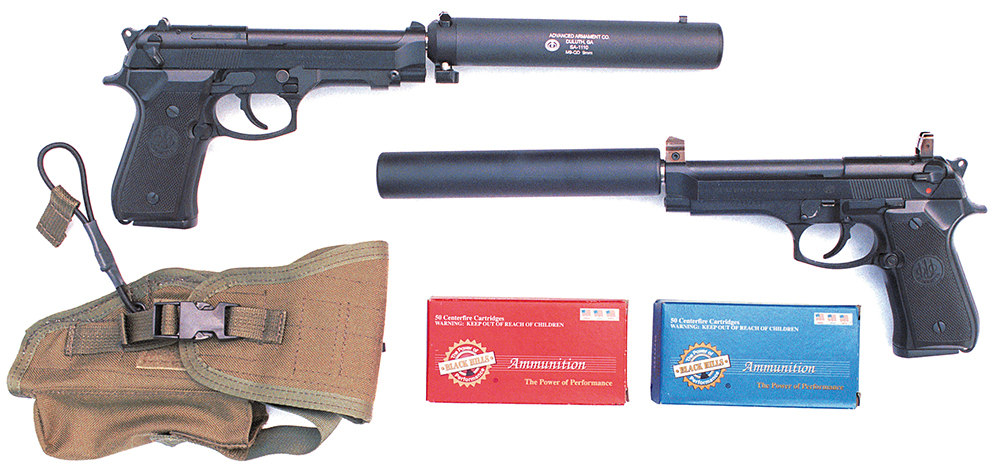By Al Paulson
Advanced Armament markets the Phantom sound suppressor to end-users who want a one-can solution for 9x19mm pistols (including the Beretta M9/92F, Taurus PT-92/99, SIG 226, Heckler & Koch P7 and P9S, and Walther P5), as well as for 9x19mm carbines and submachine guns. The suppressor can be used wet or dry, as the operator wishes. I mounted the Phantom on a Beretta PM12S submachine gun and fired 120 rounds though the little pistol can without any visible signs of wear. The Phantom’s very small size and minimal weight make it an interesting choice for submachine guns used by law-enforcement entry teams, who usually keep the selector set to semiautomatic. Another very interesting application was on a 9x19mm Ruger Police Carbine, which had its barrel shortened to 11 inches and threaded to accept AAC’s Phantom suppressor. The Ruger’s front sight had been relocated just behind the muzzle threads, and the overall length and weight of the weapon were very similar to an unmodified Police Carbine. (The weapon was registered with BATF as a “short-barreled rifle”.)
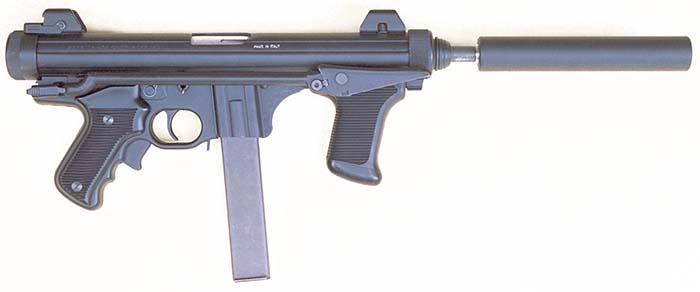
Crafted from 6061-T6 aluminum and 17-4 PH stainless steel, the Phantom is 7.0 inches in length, and 1.25 inches in diameter. Finished in a matte black hardcoat anodizing, the suppressor weighs just 5.7 ounces. While the suppressor tube and end caps are aluminum, the rear end cap features a stainless steel insert that is threaded to mate with a threaded barrel. This stainless steel insert provides much more durable threads than aluminum threads. While I’ve never personally worn out threads in aluminum end caps made in the United States (where manufacturers generally use high-quality alloys), I have seen law-enforcement cans that had been cross-threaded or repeatedly so over-torqued onto barrels by ham-fisted operators that the threading was ruined. Not every end-user has the mechanical aptitude or aesthetic sensibility of a gunsmith or advanced collector. The Phantom, therefore, provides a robust thread mount that is well suited to the both the cost-conscious collector and the armed professional. AAC’s Phantom is available in any of the following thread pitches: 1/2×28 TPI (the most common thread pitch used for 9mm cans), 1/2×32 TPI (used on Heckler & Koch MP5-N and MP5K-N submachine guns), and 1/2×36 TPI (used on Colt submachine guns).
Two very nice touches are that the Phantom, like every muzzle can made by Advanced Armament Corp., is issued with (1) a ballistic nylon belt pouch for storing or transporting the sound suppressor when it is not mounted on a weapon, and (2) a comprehensive technical manual describing the proper operation and maintenance procedures for the silencer.
While the Phantom is designed to be fired dry, adding a teaspoon (about 3 cc) of water to the rear of the suppressor really helps to cool the hot combustion gases and thereby to further reduce the weapon’s sound signature. If that’s not practical, simply dunk the can and then lightly shake out any excess water. The design of the baffle stack is very efficient at retaining water, and enough water will remain in the can to lower gunshot noise for at least 30 rounds.
Testing Versus M9-SD
I compared the performance of AAC’s Phantom sound suppressor with a quick mount suppressor made by AAC for the Beretta M9/92F. Called the M9-SD, the quick-mount suppressor is fabricated from 6061-T6 and 2024-T6 aluminum. The suppressor has an overall length of 7.38 inches (18.7 cm) and a diameter of 1.25 inches (3.2 cm). Finished in a matte black hardcoat anodizing, the suppressor weighs 6.3 ounces (179 grams). The spring-loaded quick mounting system on the M9-SD was originally developed by Knight’s Armament Company for KAC’s 9mm Snap-On Silencer and was also used on early examples of KAC’s 5.56mm M4-SD sound suppressor. AAC’s M9-SD suppressor can be used on KAC barrels without modification. New Beretta barrels with the notched extension are also available from Advanced Armament Corporation.
The M9-SD suppressor is particularly interesting because it incorporates a well-engineered rear sight and a shotgun bead front sight that enable rapid target acquisition and accurate shot placement. Like KAC’s Snap-On, the rear sight on AAC’s M9-SD is actually a part of the quick mount. The sight and locking bar on AAC’s quick mount are fabricated from 6061-T6 aluminum, the locking rods and internal sleeve that mate to the barrel extension are 14-4 PH stainless steel, and the springs were developed by noted small-arms designer Max Atchisson and are fabricated from music wire. An excellent upgrade available from Advanced Armament Corp. is the incorporation of a Meprolight tritium shotgun bead front sight, which is available for just $25 when the can is ordered from AAC.
I tested the sound signatures of suppressed and unsuppressed weapons using the specific equipment and testing protocol advocated at the end of Chapter 5 in the book Silencer History and Performance, Volume 1 ($55 postpaid, check or MO, Wideworld, Dept. SAR, P.O. Box 1827, Conway, AR 72033). Sound pressure levels (SPLs) were measured 1 meter to the left of the muzzle. Muzzle velocities were measured in feet per second using a P.A.C.T. MKIV timer/chronograph with MKV sky screens set 24.0 inches apart and the start screen 8.0 feet from the muzzle (P.A.C.T., Dept. SAR, P.O. Box 531525, Grand Prairie, TX 75053; phone 214-641-0049). Reported data represent a mean (average) value of 10 shots. The ambient temperature during the pistol and Beretta submachine gun suppressor tests was 90°F (32°C) and the speed of sound was 1,150 fps (350 mps). The MP5 and MP5 SD tests were conducted at 93°F (34°C), when the speed of sound was 1,153 fps (351 mps).
Several types of 9x19mm ammunition were used in this study: Winchester USA 115 grain FMJ supersonic, G&L 147 grain FMJ subsonic, Winchester 147 grain SXT HP subsonic, and Samson 158 grain FMJ +P+ subsonic (Cole Distributing, Dept. SAR, P.O. Box 50271, Bowling Green, KY 42102; phone 270-622-3569; fax 270-622-3757; URL http://www.cole-distributing.com/). The G&L round is no longer available but—based upon yet to be published research—it exhibits a very similar sound signature (whether suppressed or unsuppressed) to the new 147 grain RN FMJ subsonic submachine gun round being manufactured by Black Hills Ammunition.
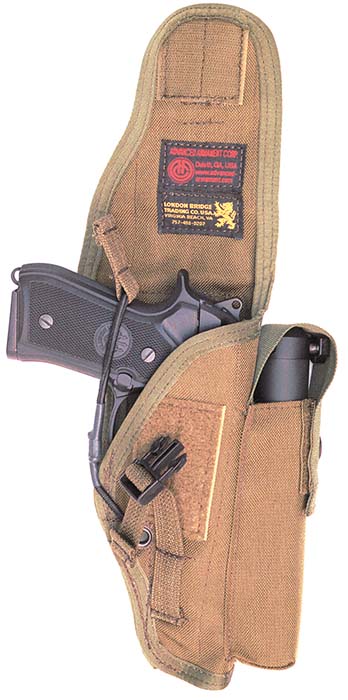
New Black Hills Subsonic
The standard 9x19mm subsonic round found in the Black Hills catalog features a flat point projectile with velocity optimized for pistols. This makes perfect sense because the vast majority of customers buying 147 grain ammo are agencies using the FMJ subsonic round as an affordable equivalent training load to 147 grain hollowpoint duty ammo used in their pistols. This FP ammo is not desirable for use in submachine guns for several reasons. Since submachine guns have greater barrel lengths than pistols, this Black Hills ammo frequently generates a loud ballistic crack in subguns, negating the value of adding a silencer to the weapon. Furthermore, FP or HP ammo doesn’t feed worth a damn in weapons that feed like Ingrams and Uzis because of the abrupt feed ramps found in these submachine guns.
The new subgun subsonic ammo from Black Hills features a round nose for reliable feeding in Ingram and Uzi submachine guns, and the round has a slower velocity for effective suppression in submachine guns over a more practical range of temperatures and barrel lengths than the catalogued FP FMJ subsonic round. This new RN subsonic is not found in Black Hills literature but is being made available as a special service, and must be ordered directly from Jeff Hoffman, the president of Black Hills Ammunition. It is in stock as this was being written. This 147 grain RN FMJ ammo is highly recommended for all silenced submachine guns. (Contact Jeff Hoffman, Black Hills Ammunition, Inc., Dept. SAR, P.O. Box 3090, Rapid City, SD 57709-3090; phone 605-348-5150; fax 605-348-9827; URL http://www.black-hills.com).
Performance
Sound signatures are reported in Table 1, while net sound reductions appear in Table 2, and velocity data appear in Table 3. Note that projectile velocities are generally a bit higher when sound suppressors are fitted to the pistol, due to a phenomenon that has been termed “freebore boost”. Also note that the MP5 SD integrally silenced submachine gun delivers substantially less velocity than the suppressed pistol.
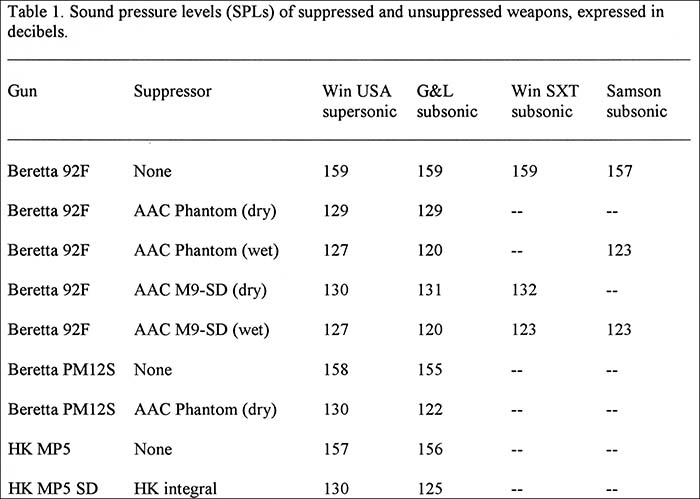
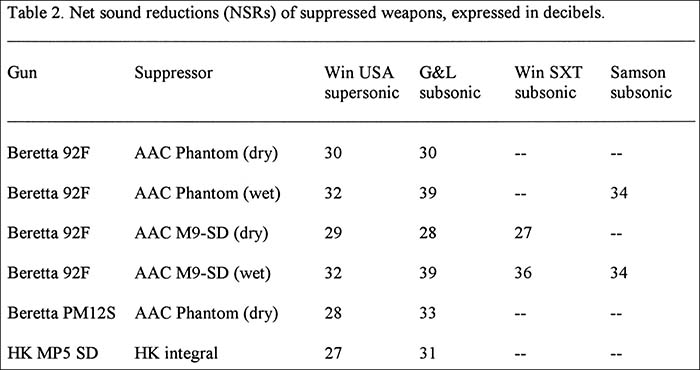
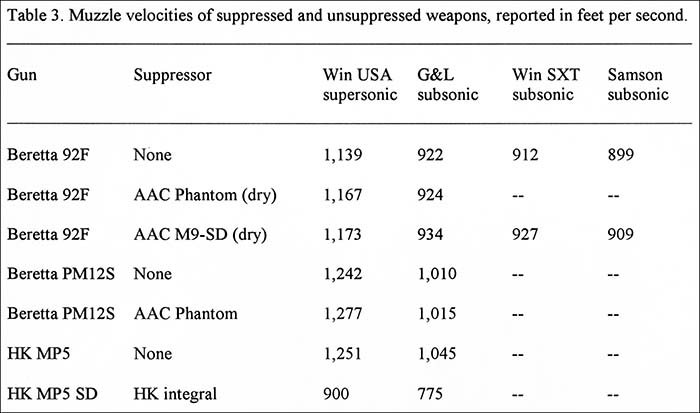
Using Winchester USA supersonic ammunition through a dry Phantom, the muzzle signature of the silenced pistol was slightly quieter the SPL of the MP5 SD. But this supersonic round produced a loud ballistic crack (sonic boom) out of the pistol, so the suppressed handgun was anything but stealthy with this round. The suppressed pistol was very stealthy, however, when employed with subsonic ammunition.
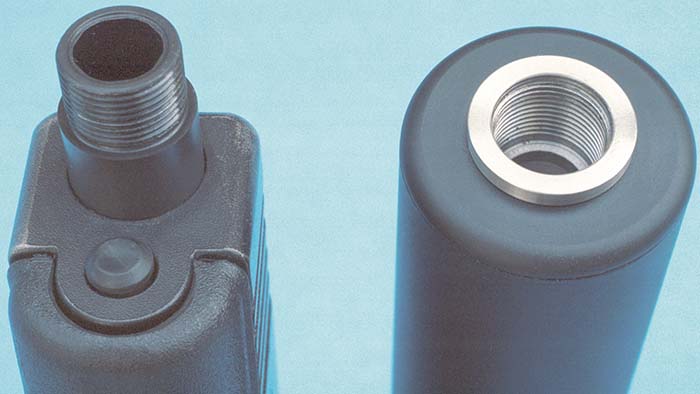
Shot dry with subsonic ammunition, AAC’s Phantom was 1 dB quieter than HK’s outstanding MP5 SD fired with standard 115 grain duty loads, which the ported barrel of the integrally silenced submachine gun drops to subsonic velocity. AAC’s Phantom was also a bit quieter than their M9-SD quick-mount can when shot side by side on the same day using both supersonic and subsonic fodder.
Adding a teaspoon or so of water to the rear of these pistol suppressors delivered noticeably better performance. AAC’s Phantom and M9-SD were significantly quieter than HK’s MP5 SD. To test the retention of coolant in AAC’s 9mm pistol suppressors (both of which use similar internal designs), I fired thirty rounds of subsonic ammunition through the M9-SD suppressor without replenishing the 3 cc of water that was initially added to the rear of the suppressor as a coolant medium. Thirty rounds greatly exceeds any realistic mission requirement. The sound signature of the thirtieth round was only 0.4 dB louder than the first shot. This is impressive performance, to say the least.
I also evaluated a new holster designed to carry a Beretta M9/92, SIG/Sauer P-226, or Colt M1911A1 along with AAC’s 9mm Phantom or M9-SD, or AAC’s .45 caliber Orion sound suppressor in a pouch attached to the front of the holster. The M9-Holster is made exclusively for AAC by the London Bridge Trading Company, which has been quietly supplying the armed professional with top-quality nylon gear for more than 15 years. The holster features a full flap that protects the pistol and is secured by both hook/pile and quick-release fasteners. An elastic loop (rubber coated bungee), which is an innovation peculiar to London Bridge holsters, can be slipped around the butt of the pistol as an added measure of security for airborne or amphibious operations. The suppressor pouch on the front of the M9 Holster is secured by both hook/pile and a snap. The holster provides two modes of attachment: a wide belt loop and Alice clips. Thus, every aspect of the holster design offers “repetitious redundancy” that appeals profoundly to my biases. The quality of materials and construction are outstanding, as is the thought that went into the holster’s design. It is my understanding that a version of the London Bridge holster is used by U.S. Navy special warfare units. Available in black and olive drab, the M9-Holster with suppressor pouch is as good as it gets, and I can recommend it with enthusiasm.
How would I summarize the performance delivered by Advanced Armament Corporation’s Phantom sound suppressor? It provides world-class performance in terms of sound suppression. When shot wet, AAC’s Phantom is much quieter than HK’s MP5 SD integrally suppressed submachine gun. The Phantom also delivers significantly better velocity, which translates into better penetration. AAC’s Phantom works very well dry and extremely well wet. A key feature is that the Phantom incorporates a stainless steel insert that provides very robust threads for mounting the can on a threaded barrel: Each AAC suppressor comes with a durable black belt pouch made of nylon webbing and ballistic nylon, which is a really handy concept. If the Phantom will be used entirely as a submachine gun can and will not be used on pistols, then the Phantom can be special ordered with a stainless steel blast baffle for maximum durability. Finally, AAC can provide a superior quality holster to carry both pistol and sound suppressor. Thus the Phantom isn’t merely a 9mm silencer providing outstanding sound reduction. It’s part of a well thought out system designed to be used in the field. I like that concept. The Phantom retails for $450 and includes a lifetime warrantee. For more information, contact the Advanced Armament Corp., Dept. SAR, 221 West Crogan Street, Lawrenceville, GA 30045 (phone 770-277-4946; fax 963-6556; URL www.advanced-armament.com).
| This article first appeared in Small Arms Review V4N7 (April 2001) |



